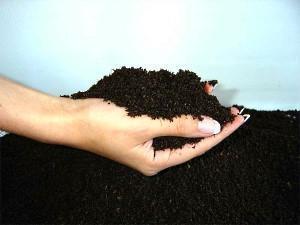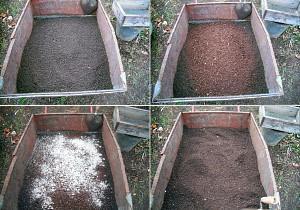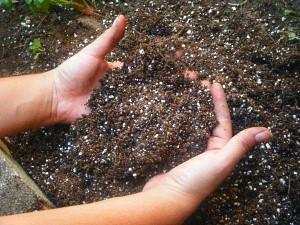Self-preparation of soil for seedlings
 Seedling soil is a mixture of organic components and inorganic impurities. This is the basis for the development of the root system, normal growth and fruiting of the plant. The yield will depend on the correct preparation of the soil for seedlings.
Seedling soil is a mixture of organic components and inorganic impurities. This is the basis for the development of the root system, normal growth and fruiting of the plant. The yield will depend on the correct preparation of the soil for seedlings.
What is the best soil for seedlings?
You can use purchased seedling soil. Convenient, fast and no hassle. They are all made on the basis of peat. But here you can face the problem, which mixture to choose? In order to choose a high-quality soil for seedlings, you need to understand the components or consult a professional in a specialized store.
You can save money and not be disappointed in the results by preparing your own soil for seedlings. It's not as difficult as it sounds. The main thing is to follow the basic rules and recommendations for the prepared soil.
Basic requirements for prepared soil
The prepared soil should be:
- fertile and balanced;
- light, porous, loose;
- absorb moisture well;
- have an average level of acidity;
- contain microflora.
The prepared soil should not contain:
- clay;
- weed seeds;
- actively decomposing components;
- pathogens, larvae, worms;
- toxic substances.
Organic components and inorganic impurities
To improve the quality of the soil for seedlings, both inorganic impurities and organic components are used. It is important to know which ones can be used and which ones can not.
Organic ingredients
Suitable organic ingredients:
- wood ash;
- eggshells (raw, crushed);
- high-moor peat;
- transitional peat;
- sphagnum moss;
- low-lying peat (after freezing, weathering);
- sawdust of coniferous and deciduous trees;
- heat treated sod land.
Unsuitable organic ingredients:
- humus;
- small shavings of any wood species;
- low-lying peat without processing;
- leafy land;
- hay, straw dust;
- sod land without cultivation;
- composts of all kinds;
- sawdust of painted wood.
Inorganic impurities for soil
Suitable for use:
- washed bottom, quartz and river sand (excellent baking powder);
- perlite (increases soil looseness and air permeability);
- hydrogel (maintains the level of moisture);
- vermiculite (has the properties of perlite, contains small amounts of potassium, magnesium, calcium);
- shredded foam;
- pumice;
- expanded clay.
Unsuitable for use:
- not washed river sand;
- quarry sand with clay.
How to prepare soil for seedlings with your own hands?

Disinfection methods
There are many disinfection methods. They all have both pros and cons. The most commonly used methods are:
- freezing;
- steaming;
- calcination.
To destroy weeds and some of the pests and at the same time not turn the soil into a lifeless substrate, you can apply the freezing method. It consists in constant alternation: freezing - thawing. Boxes with earth are taken out into frost, sheltered from precipitation. After thoroughly freezing, they are brought into a warm room. Scattered with a layer of no more than 8 cm, moisten with water. The boxes with soil are kept warm for about a week, then they are again taken out into the cold.
The freezing method partially disinfects and heals the soil, but at the same time does not kill the entire infection (spores of keela, late blight).
 Steaming is best done a month before applying the seedling soil. The soil must be steamed in a water bath with a closed container lid for at least 3 hours. The calcination method takes place in an oven preheated to +40 for about 30 minutes. Heat treatment (steaming and calcining) kills all pathogens as well as necessary microorganisms. Therefore, before sowing, the components necessary for the restoration of microflora are added to the ground.
Steaming is best done a month before applying the seedling soil. The soil must be steamed in a water bath with a closed container lid for at least 3 hours. The calcination method takes place in an oven preheated to +40 for about 30 minutes. Heat treatment (steaming and calcining) kills all pathogens as well as necessary microorganisms. Therefore, before sowing, the components necessary for the restoration of microflora are added to the ground.
The already prepared soil can be disinfected with a medium intensity manganese solution.
Components that do not require pretreatment
For a good structure of the substrate, the following are suitable: river sand, sawdust of coniferous and deciduous trees. Coniferous sawdust does not require pre-treatment. The only thing is that you can not use sawdust that is saturated with diesel fuel. It is enough to wash the river sand and free it from stones.
Soil composition
 The composition of the seedling soil directly depends on the requirements of the crop that you will plant. For example, for pepper, cucumber, onion, eggplant, a composition is suitable: 25% earth, 30% peat, 25% sand.
The composition of the seedling soil directly depends on the requirements of the crop that you will plant. For example, for pepper, cucumber, onion, eggplant, a composition is suitable: 25% earth, 30% peat, 25% sand.
For cabbage, the percentage of sand can be increased to 40%.
For a tomato, the proportion of land can be increased to 70%.
The recipe is suitable for almost any seedling: 1 part of drainage, 2 parts of organic matter, 2 parts of soil, using ash or lime, we lower the acidity.
If it is necessary to increase the acidity of the soil, dolomite flour can be used as a deoxidizer.
During the growth of seedlings, it is good to use water with diluted mineral fertilizers. But do not oversaturate the soil for seedlings with them. Everything should be in moderation.
Buy or independently prepare soil for seedlings, of course, you decide. But having selected the necessary soil composition once, you do not have to constantly spend money on substrates of little-known manufacturers.